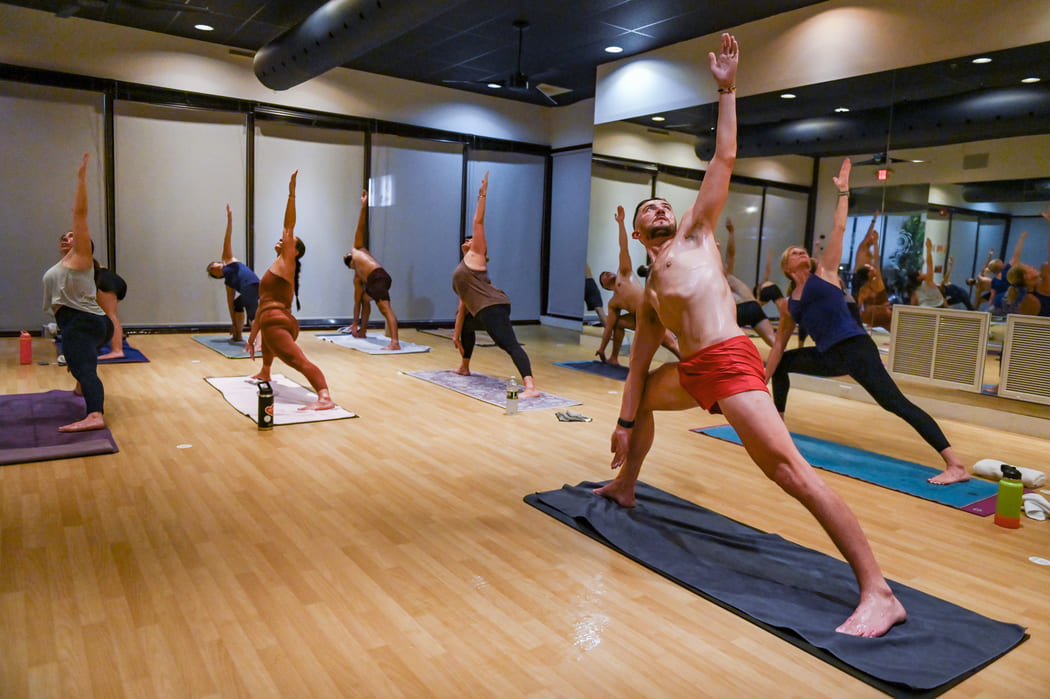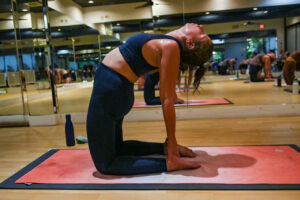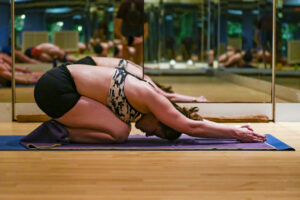Ever watched a surfer riding the waves? Maybe it looks easy, but behind the gracefulness, is a whole lot of balance, patience, and practice. The Balancing Stick Pose, or Tuladandasana, is kind of like surfing your yoga mat.
Translated from Sanskrit, Tuladandasana means “balancing on a stick.” It asks us to stand strong and steady like a tree, while stretching tall and leaning forward. The pose is a practice in patience and invites you to stay present with your breath. Although it might take a few tries, stick with it. Tuladandasana is a journey of growth, not a destination (a little like life, don’t you think?).
Here’s what this article covers
Performing the Balancing Stick Pose
FAQs About Balancing Stick Pose
Performing the Balancing Stick Pose
Step by Step, breath by breath.
- Begin by standing tall and strong at the top of your mat, feet hip-distance apart. Feel the earth beneath your feet.
- Shift your weight onto your right foot. Lift your left foot a few inches off the ground. Honor your balance.
- Next, breathe in deeply and as you exhale, lean your upper body forward while extending your left leg back. Strive for your body and leg to be parallel to the ground. Your body is a living, breathing balancing stick. It’s okay if you wobble – trees sway in the wind too!
- Turn your gaze to the floor, a few feet in front of your mat. Breathe. Hold this pose for a few breaths – or as long as you can maintain good form.
- To come out of the pose, breathe in, lowering your left leg and raising your upper body.
- After that, repeat on the other side.
Benefits
Tulandandasan brings so many benefits to both your mind and body. With some practice, you may notice that you’re standing taller, your body feels stronger and you have better posture. The pose is great for activating your core muscles, relieving pressure on your spine and improving balance.
Tuladandasana isn’t just for your physical body, this pose is therapeutic for your mind as well. It’s calming, and with practice, may provide a sense of peace and balance in the pose – and beyond the mat.
From an energetic standpoint, Balancing Stick Pose is believed to stimulate our crown chakra (Sahasrara). In yoga, chakras are unseen energy centers that balance our being. The crown chakra, located at the top of our head, is linked to spiritual connection and awareness.
Ease Into Tuladandasana
Whether you’re a seasoned yogi or just beginning your Bikram yoga practice, use these 6 preceding poses to prepare your body for the Balancing Stick Pose:
Poses one through three-
- Pranayama (Deep Breathing Pose): Stand tall on your mat, feet hip-distance apart, with your hands clasped under your chin, elbows opening wide. Inhale deeply through your nose for six counts, feeling the expansion of your chest and the gentle motion of your elbows.
- Ardha Chandrasana (Half Moon Pose): Reach your arms to the sky, and with an exhale, lean to your right, stretching your left side body. Now, inhale back to center, and then exhale, lean to your left, stretching your right side.
- Utkatasana (Awkward Pose): Root your feet into the ground, straight and about 6 inches apart. Next, lower your hips as if sitting back into an imaginary chair, extend your arms forward, parallel to the ground, and lean your upper body slightly back, chest forward.
Poses four through six-
- Garurasana (Eagle Pose): From Utkatasana, rise slightly, cross your right thigh over your left, and hook your right foot behind your left calf if possible. Extend your arms straight in front of you, cross your left arm over your right, bending at the elbows and touching your palms together.
- Dandayamana-Janushirasana (Standing Head to Knee Pose): Return to standing, then softly bend your knees, lift your right foot, and cross it over your left thigh. Next, bend your elbows, interweaving your forearms so your palms touch, and lift them in front of your face, gazing towards your fingertips.
- Dandayamana-Dhanurasana (Standing Bow Pose): Stand tall again, lifting your left foot behind you and reach your left hand to grasp the ankle. Extend your right arm forward and tilt your torso forward as you kick your left foot into your hand, creating a backbend, then repeat on the other side.
Remember, each posture is a step forward in your practice, an opportunity to learn more about your own strength and flexibility. Every breath in and out is a testament to your focus and dedication. Each time you step on the mat is a new chance to improve and grow. Explore the 26 poses that we practice during our Bikram hot yoga classes here.
Modifications
Yoga is about being present with ourselves and listening to our bodies. We invite you to adjust and modify this pose as needed. Here are some modifications you could make:
Use a wall for support: If your balance is a tad wobbly, no worries! A wall can provide a stable point of contact. While you might not get the same deep stretch, it helps to align your body and instill confidence in the posture.
Don’t lift your leg as high: If your leg says, “not today” to going all the way up, that’s okay! You can keep it slightly bent or not raised it as high. The key is to feel comfortable and stable in the pose, and these adjustments are perfect stepping stones in your Tuladandasana journey.
Consider a strap or belt: If you find it difficult to hold your leg out straight behind you, a yoga strap or even a simple belt can be looped around the foot to provide some extra length and support.
Bend the standing leg: If you feel strain in your standing leg, it’s perfectly acceptable to keep a gentle bend in the knee. As your strength and flexibility improve, you can work towards straightening the leg.
FAQs About Balancing Stick Pose
I worry I may pull a muscle or injure myself trying to do this pose.
Yoga is about listening to your body and honoring its limits. We encourage gradual growth – no pose should cause you pain. Making modifications when a pose doesn’t feel right for you is part of the process and encouraged.
What if I can’t stay in the pose for the whole time?
In our hot yoga classes, we focus on being present with ourselves, and the space we share – not the duration of a pose. If you’re in Tuladandasana for only a few breaths, that’s a wonderful start.
What if I’m the only one who can’t get into the pose?
It’s natural to look around and compare, but remember that yoga is a personal practice and not a performance. No one else’s progress diminishes your own. When it comes to Tuladandasana, or any other pose, the goal is not to look like everyone else. The goal is to feel a sense of connection and peace within yourself. So, even if you’re the only one modifying or taking a rest, you’re still perfectly aligned with the heart of yoga.
 -ing our NEW! Community Classes!
-ing our NEW! Community Classes!






